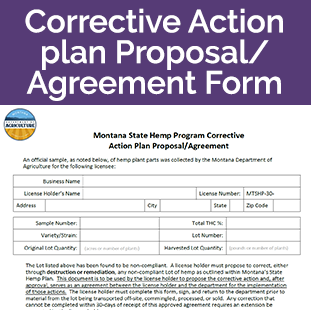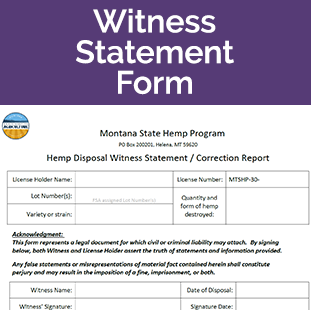Disposal and Remediation of Hemp
Any Lot of hemp that tests above the Acceptable Hemp THC Level (greater than 0.3% Total delta-9 THC) from an official sample is non-compliant and must be either properly disposed of or remediated according to department procedures. The level of THC will determine which option can be utilized. All hemp plants and plant parts of a non-compliant Lot destine for remediation or disposal must be clearly labeled as such.
Upon notification from the department that a Lot has tested above the Acceptable Hemp THC Level, it is the licensee’s responsibility to notify the department of their decision to either remediate or dispose of the non-compliant Lot. The proposal form can be found by clicking the box below. The form will be provided to the license holder along with the test results of each non-compliant sample.
Remediation
Notice: Chemical or physical extraction and/or dilution of THC is no longer an allowed process for remediation of non-compliant hemp lots.
A Lot of hemp testing above the Acceptable Hemp THC Level and less than 1.0% Total THC may be considered for remediation. Remediation must include all plants and plant parts of the Lot.
Crops verified by the department to be marketed solely as a fiber commodity may be considered for remediation if test results are less than 2.0% Total THC from a pre-harvest sample.
Remediation refers to any process by which non-compliant hemp is rendered compliant (≤ 0.3%). Remediation can be achieved by either:
- separating and destroying non-compliant flowers (including buds, trichomes, “trim,” and “kief”) while retaining stalks, leaves, grain, or seed; or,
- Acceptable methods for the removal of non-compliant flowers and floral material under this remediation strategy include but are not limited to the removal by hand or mechanical equipment, or through retting for solely fiber crops, and the proper disposal of as outlined herein while maintaining separation of salvageable stalks, leaves, grain or seed;
- Seeds removed from non-compliant hemp during remediation shall not be used for propagative purposes.
- shredding the entire hemp plant (including all flowers, buds, trichomes, “trim,” “kief,” leaves, stalks, and seed or grain) to create a homogenous “biomass”.
- Acceptable methods for the creation of biomass under this remediation strategy include, but are not limited to, the shredding of hemp plants through shredders, composters, or specialty mechanical equipment.
Regardless of the remediation method used, the remediated material must be resampled and retested to ensure compliance before entering the stream of commerce. All Lots subject to remediation should be labeled as such and stored apart from each other and from other compliant hemp Lots stored or held nearby. Remediated material should not leave the labeled and demarcated area until a test result showing compliance with the acceptable hemp THC level is received or until the material will be destroyed. The licensee is responsible for any inspection, sampling and testing fees related to a hemp Lot being resampled.
Disposal
Any disposal or destruction of hemp, whether voluntary or by order of the department must comply with state and federal regulations. The license holder is responsible for assuring the non-compliant hemp plant or plant parts are rendered into a non-retrievable or non-ingestible form and is non-viable for further propagation, distribution, or sale. The license holder is also responsible for the control and destruction of volunteer plants of hemp not registered under an active license.
Disposal of hemp plants will be required for:
- a lack of records indicating the hemp was produced by a properly licensed producer or on a registered growing site,
- a lack of control by the license holder,
- official test results showing a Total THC level that exceeds 2.0% on a dry weight basis, or
- official test results showing a Total THC level that exceeds 0.3% on a dry weight basis without an approved corrective action plan.
The disposal of any hemp Lot must include all plants and plant parts of the Lot. The disposal must be conducted either by using a DEA-registered reverse distributor or law enforcement, or on site at the farm or hemp production facility. Allowable disposal methods include:
- plowing, tilling, or disking plant material into the soil;
- mulching, composting, chopping, or bush mowing plant material into green manure;
- burning plant material;
- burying plant material into the earth and covering with soil; or,
- a combination of the above methods.
For Lots, plants or plant parts that are required to be disposed of by the department, the producer must request approval from the department through submission of a proposed corrective action plan. Upon approval, the applicant must perform the disposal accordingly and within the given timeframe. To successfully complete the process, the producer must provide pictures or videos showing proof of destruction and the Witness Statement form signed by the license holder and an independent third party verifying the destruction.



